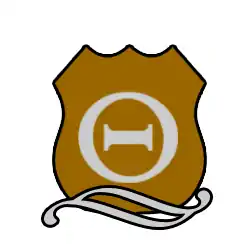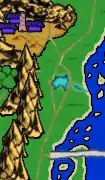Kerrigan (3.5e Environment)
The Eastern Coast of Loupe is home to the nation of Kerrigan, the last home of the dwarves and a large stretch of coastline. These plains and coastlines have been advantages to the inhabitants of the region, controlling large portions of the shipping lanes as far out as Fairus.
| Capital | |
| Ironhollow | |
| Government | |
| Representative Republic | |
| Leaders | |
| 12 Representatives | |
| Associated Deities | |
| Terros, Undine, Feylgara | |
| State Language | |
| Common, Dwarven, Aquan | |
| Diversity | |
| 30% Human, 32% Dwarf, 11% Elf, 23% Merfolk, 4% Centaur | |
Climate, Geography, and Wildlife
A long, gorgeous coastline and accompanying plains is what generally defines most of Kerrigan. Named after the last of the dwarven kings, whose line perished when he and all his sons were killed during the great wars that nearly forced their kind to go extinct once and for all, the land is blessed with resounding beauty and a diverse environment. Weather is probably more moderate in Kerrigan than other areas on Loupe, which experience either drastically severe or calm weather, leaving Kerrigan with a more relatively predictable climate, following the seasons of Autumn, Winter, Spring, and Summer. All types of weather are known to occur in Kerrigan.
The plains are generally the most noticeable feature of the region, though one might experience the gradual hill here and there, especially as travelers near the Indus border. Towards the west, the mountain ranges that encompass Tirasus are a constant, all the way up and through Ironhollow and into Indus, as is the ocean to the east, leaving the region as a peninsula. The immediate area surrounding Ironhollow, however, is much different. Having been stripped of most of its minerals in attempts to mine, the area resembles a rocky plain with little vegetation.
Wildlife is rather moderate in Kerrigan, like the weather. While neighboring Tirasus contains primal, more aggressive beasts that can sometimes find ways into Kerrign, the region generally enjoys the occasional lion as its most significant wildlife, along with wolves, deer, and other familiar animals. Indigenous Centaurs, while not wildlife, often roam along the region, as well.
History
Kerrigan was first settled by dwarves, but only to the point of the city of Ironhollow. The rest used to belong to the Kaladonian Empire of times past, with most of the original dwarven empires underground. After the dwarven wars, most of the dwarves retreated to Ironhollow, and prepared themselves for a last stand against the empire. It was only soon after that the capital city of Kaladon suffered the mysterious events that destroyed the empire, and left Ironhollow and the remaining population of the dwarves to try and rebuild their devastated civilization. With the empire having been dissolved, the areas surrounding Ironhollow soon became under the control of the dwarven nation, who later named the lands after their last king and his family, forever remembering King Kerrigan the Ironsided so long as the nation continued to survive.
Government
Dwarven tradition dictated that only those of the royal bloodline could be king, and rule over the dwarves; The problem came when Kerrigan was killed in the wars, so were his sons. There was no royal successor, and every potential along the line ended in failure to find a suitable heir. Because they could not have a king, the dwarves of Ironhollow constantly argued over how they were to survive and continue to allow their civilization to flourish with no leadership, often meeting in a grand hall designed for the former king. This continued on, and soon transformed into what the government of Kerrigan is, now; A republic where representatives of all districts of the nation argue and debate legislation.
While originally a dwarven nation, entirely, as Kerrigan began to assimilate more and more leftover Kaladonian culture, and receive immigration and foreign trade, as well, the Grand Hall of Representatives began to fill with other races, who now jointly debated the future of their collective nation alongside the dwarves.
Foreign Relations and Military
Kerrigan, from its very roots, has been entangled in foreign relations and war. An older nation than many of it's neighbors, its creation dates back to near the end of the Kaladonian empire, and thus has mostly interacted with the Kaladonian people, though in recent years, it has also been well intertwined with the modern nations, as well, especially Tirasus, the Ashen Coast, and Silverfell over various issues and disputes. Tirasus shares the burden of the Goblin tunnels in the mountains separating the two nations, while Silverfell disputes the claim over Fairus that Kerrigan has. The Coast has generally just challenged territories to the south, but little more.
Kerrigan is more defensive than most nations. It has little offensive allocations, but each border is line with patrols by infantry and scout cavalry, and the military favors medium or heavy armors, with large garrisons in every major town.
Language, Religion, and Culture
Naturally, the most spoken language and the first to be adopted at the state level would have been Dwarven, given that this is the last home of the dwarves. That said, over time, the remnants of other civilizations have managed to creep into Kerrigan, forcing the state to recognize common and aquan as well, due to the large numbers of human and merfolk peoples that began to live in the region.
Most of the citizens of Kerrigan worship Aesirean gods, prominently Feylgara and Undine, Goddesses of Stone and Water, respectively. These factions begrudgingly accept those who worship gods of the pantheon, especially the larger sect of Terros, god of the lands. These factions butt heads often, due to the conflict between Aesir and the Pantheon, and the stubborness of dwarves who worship them. Other races do not have such quarrels as often as dwarves do, however.
The culture of Kerrigan exemplifies traditional dwarven teachings above all else. Drinking, Fighting, and Crafting are all inherent in the people of the land, as well as masonry and architecture. Rarely are wooden buildings ever seen in Kerrigan, the few existing perhaps belonging to the Merfolk who settle along the shores.
Cities
Ironhollow, Capital of the Kerrigan Region
The seat of Kerrigan is Ironhollow, a industrial town found in the northern reaches of the region, nestled in the same mountains that surround Tirasus to the southeast. The architecture of Ironhollow is second to none, even if it lacks the variety and numbers of other cities, like Goldengate, further proving that none are better with stone and hammer than the dwarves. Most of the city is actually built into the sides of the mountains, with a magnificent Hall against the mountain as well, in the center of all the other buildings and carvings that have been made over the years. This hall is the Grand Hall of Representatives, where all officials come to deliberate on issues concerning the republic. Major temples to Feylgara and Terros are found, here.
Waterside
A Town located between the Neead lake in central Kerrigan, and the Coastline. This small city is home to most of the Merfolk that inhabit Kerrigan; While merfolk can be found elsewhere in Kerrigan, and other races can be found in Waterside, these are both relatively small statistics, making Waterside the only land-based city to contain predominantly Merfolk, likely in the entire world.
Delver's Post
This small fortress town is located near the mouth of the region, at the border of the Ashen Coast. It serves a checkpoint for all who enter the region from the south, and even as a small trade town for travelers before heading north to Ironhollow, or east to Fairus.
Other Notable Sites
- Neead Lake; According the the Merfolk, whole caverns of lost treasures used to be stored here. A few centuries ago, however, these areas became inaccessible due to strange currents in the lake.
- Crystal Caverns; In the western portion of the region, directly south of Ironhollow, there is a strange cavern that is filled with mirror-like crystals. During the day, the entire cavern is lit, but during night, it is pitch black. It has never been fully explored due to the crystals also mirroring each other, and any party can easily be lost within.
Back to Main Page → 3.5e Homebrew → Campaign Settings → Tirr Campaign Setting
Back to Main Page → 3.5e Homebrew → Environments

